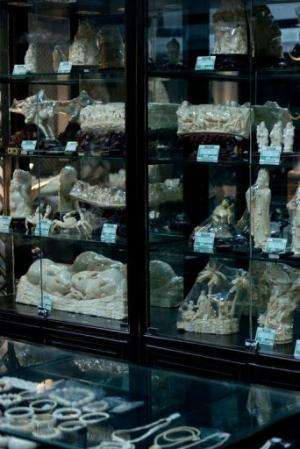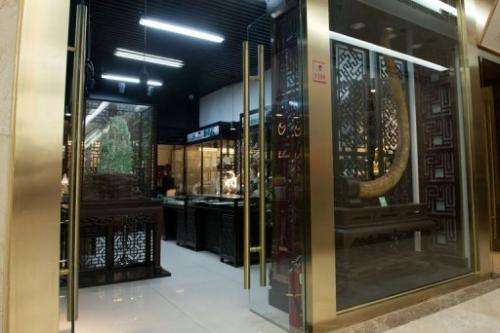Charging China demand drives deadly ivory trade

Surrounded by sculptures carved from the white tusks of African elephants—which are being slaughtered in their tens of thousands—Beijing saleswoman Chen Yu says the ivory trade is thriving.
"Business is good," Chen said, pointing out a 1.2 million yuan ($200,000) ivory statue of Buddhist figure Guanyin, who is associated with compassion. "That's one of our biggest sculptures... it was carved in Beijing," she said.
Surging demand for ivory and rhino horn in Asia is behind an ever-mounting death toll of African elephants and rhinos, conservationists say, as authorities fail to rein in hugely lucrative international smuggling networks.
Policy-makers meet in Bangkok on Monday for the triennial meeting of signatories to the world's most important agreement on wildlife trade, the Convention on International Trade in Endangered Species of Wild Fauna and Flora (CITES).
The World Wide Fund For Nature (WWF) last week singled out Thailand, Nigeria and the Democratic Republic of Congo for tough sanctions to halt what one spokesman called "a poaching crisis... of the kind that we haven't seen in a long time".
WWF estimates that around 25,000 elephants were hunted for ivory in 2011, and predicts an even higher toll for 2012. There could be as few as 470,000 left, it says.
The situation facing rhinos—of which only about 25,000 remain in Africa—is also bleak, with a record 668 killed for their horns in South Africa alone in 2012, up nearly 50 percent from the previous year.
Activists report that hunting gangs in Africa slaughter entire herds of elephants, and dozens of rhinos, to feed smuggling chains which stretch to eager consumers in East Asia, all avoiding intervention by the authorities.

Experts are clear that most illegal ivory is headed to China, with some estimating the country accounts for as much as 70 percent of global demand.
"China is the leading end-use market for ivory in the world today," Tom Milliken from the wildlife monitoring network TRAFFIC told AFP.
China's surging economy has created millions of wealthy consumers, many of whom are keen to buy ivory carvings—seen as a status symbol for centuries.
The price of ivory in China nearly tripled from 2006 to 2011, the Canada-based International Fund for Animal Welfare (IFAW) has said, making it an attractive investment and a valuable gift.
"Our customers don't buy the sculptures for themselves—they are usually given as presents," said Chen.
CITES banned the international trade in ivory in 1989—a historic step which led to a drop in elephant killings.
But like other countries, China permits the resale of ivory bought before the ban—and also has a stockpile purchased with CITES approval in 2008, in an attempt to reduce the black market, which it releases for sale with certification.
Chen insisted that the ivory sold in her shop, plastered with signs warning buyers not to take their purchases out of the country, is entirely legal. "There are a lot of limitations on the trade," she said.
But China's legal ivory shops mask an illegal market which is six times larger, according to IFAW, which says that more than half of legal Chinese ivory stores also sell illegal products.
A thriving trade in uncertified ivory exists on Chinese websites, with thousands of products on offer, from necklaces to chopsticks.

Reports have also said that ivory gifts are favoured by members of China's military—hinting that official corruption is a key source of demand, as well as a barrier to cracking down on the trade.
"The main problem is law enforcement against illegal trade in ivory," said Jianbin Shi, from WWF's Beijing office. "China needs to increase law enforcement efficiency and effectiveness by increasing the rate of prosecution."
China however defends its law enforcement efforts, which have resulted in several prison sentences for ivory smugglers.
Beijing "attaches great importance to the protection of endangered wildlife," a foreign ministry spokeswoman said this week.
Ivory sculptures are also prized in Thailand, often as religious items sold to Buddhists, and ivory is openly available in tourist shops.
Conservationists last week urged Thailand to ban all ivory sales, and called for sanctions against the country unless it did so.
Elsewhere in Southeast Asia, Vietnam has become notorious as the centre of a flourishing trade in rhino horn.
Ground horn powder has long been valued in traditional medicine, but it is now also favoured by young, wealthy Vietnamese, who pass it around in sachets after parties as a hangover cure, according to the WWF.
"It is fashionable to own and consume rhino horn, which is more expensive than gold in Vietnam," said Dang Thu Huong, a traditional medicine seller in Hanoi. The last prosecution for smuggling horn into the country was reportedly in 2005.
Experts say Hong Kong, which has confiscated more than six tonnes of ivory since last October, is one of the key transit points for the tusk trade in Asia—along with Malaysia, the Philippines and Vietnam—with routes going on to China.
On a busy street in central Beijing, Chinese basketball star Yao Ming stares down from a billboard in front of a picture of an elephant carcass—part of efforts to stem Chinese consumers' voracious demand for ivory.
But Chen is not worried that such campaigns will affect business. "We have a lot of customers," she said, glancing at a metre-long tusk in her shop window. "Prices keep on going up."
(c) 2013 AFP





















